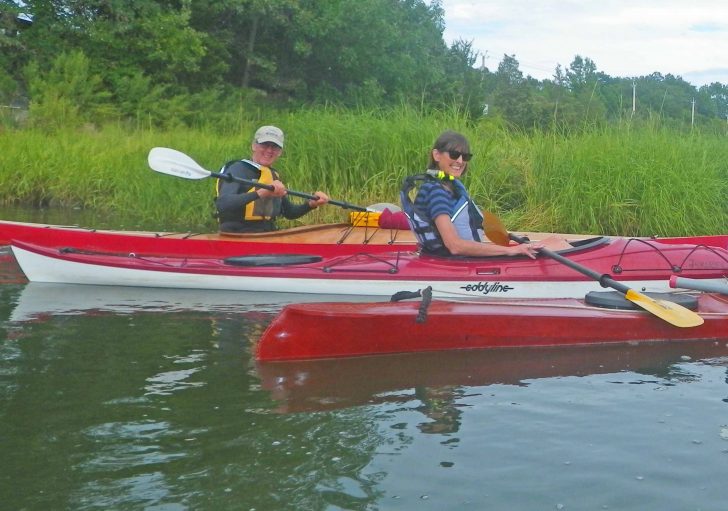Many of us older kayakers are having various senior setbacks. But we all love kayaking and won’t let those stop us. We know the benefits: low impact; connect with others; get out in nature; intellectual stimulation involving navigation skills and tide charts.
Here are ten tips worth reconsidering to make kayaking easy on us.
1. Go light. Lifting a kayak on and off cars or the beach can strain your back. Light kayaks made of carbon fiberglass material can be well worth the investment. More kayak manufacturers, recognizing the needs of the older paddler, are reducing weight using various materials. Aim for a boat 35 pounds or less. Consider a wood kayak, which is light, durable, lively, and lovely to look at.
2. Invest in a good paddle for ease of swing weight. Again carbon light materials can be expensive but well worth the price, and wood is a good option. Consider a Greenland paddle. It has a longer and narrower blade that lessens the upload on your arms and shoulders.
3. Lifting your kayak on and off a car, especially as a solo paddler, can be onerous. Thule makes something called a Hullavator, a mobile rack that allows you to load the kayak at waist level on the side of the car, then lifts it onto a rack on top of the car. A strut device eases most of the kayak’s weight.
4. Most kayak accidents occur on land, on rocky shores where you may slip on seaweed. Always step in between the rocks, not on top of them.
5. A kayak cart removes the need to haul on your shoulders. You can even rig up a cart to a bike to get your boat to the water. If you ever go to the Adirondacks, where portaging from one pond to another is de rigeur, you will see seniors everywhere using kayak carts. Strap them to the back of your kayak when not in use, or stow them in the rear hatch. Nothing says portage better than kayak cart.
6. The usual kayak safety planning is even more important as you get older. File a float plan with a family member or friend. That indicates your proposed route, time of return, and a description of your kayak. Other useful (and in some cases mandatory) items: a weather radio to indicate wind force and direction; cell phone in waterproof case or hand-held VHF; a pfd (personal flotation device); whistle; and a wetsuit or drysuit if you are paddling in cold water. Hypothermia from cold water immersion is one of the kayaker’s biggest challenges.
7. Carry a tow rope, so you can tow the grandkids in their kayaks back to shore if they get tired, or so they can tow you! Towing is a remarkably easy way to assist someone back to shore.
8. In the off season, lift light weights to keep shoulders and arms strong. Or check out the spring training session in our April issue.
9. Do yoga to assist in balance and flexibility, especially key for getting in and out of your kayak.
10. It’s best to venture out in less traffic. Avoid busy summer weekends when motorboat and Jet Ski traffic is at its most frantic… and noisy. Go early in the morning, when the water is tranquil, and the world is yours.
Happy Spring Paddling!

